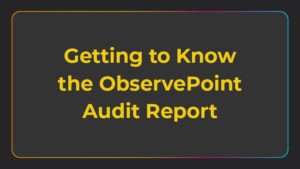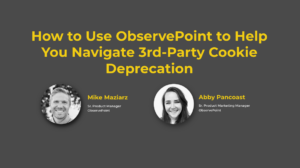7-Step Adobe Analytics Solution Design Reference [with SDR Template]
![7-Step Adobe Analytics Solution Design Reference [with SDR Template]](https://resources.observepoint.com/wp-content/uploads/7-Step-Adobe-Analytics-Solution-Design-Reference-with-SDR-Template-1024x576.webp)
If you’re an Adobe Analytics user, a solution design reference that documents what data you’re collecting and how it ties back to your business requirements is essential.
This article will explain in seven strategic steps (with a template) how you can create and maintain an effective solution design to protect the integrity of your analytics implementation. Once you have a tagging plan, an automated solution like ObservePoint’s auditing technology can help you verify that your existing implementation matches what you have documented in your SDR.
As you go through this guide, feel free to use this complimentary SDR template.
What Is a Solution Design Reference?
A solution design reference (SDR) is a document that defines business requirements identified by stakeholders throughout your organization, mapping them to key performance metrics that can be measured across your digital properties using Adobe Analytics. It’s essentially a blueprint for your website’s Adobe Analytics tagging implementation. Without an SDR, you won’t have a clear idea of what your Adobe Analytics is tracking and why.
A more vendor-agnostic term for a solution design reference is a tagging plan. While an SDR could refer to implementation documentation in general, it tends to refer specifically to an Adobe implementation. The solution design helps analytics architects know where, when, and how to implement code.
To stay nimble with changing business objectives and multiple digital properties, if you have them, you will want to create a dynamic SDR so that all departments involved in digital tagging are on the same page.
Read on for 7 steps to create your own SDR.
1. Determine the Ownership of the Solution Design
Establish who is responsible for maintaining your solution design. The creation and maintenance of a solution design falls upon the shoulders of analytics stakeholders, headed by a governance leader. These leaders are responsible for deciding what objectives the organization has in its web analytics implementation and how to best achieve those goals.
By clearly establishing stewardship over this high-touch document, you can make sure all members of your organization across all departments remain accountable to it.
2. Format the Solution Design to Be Easily Edited
A solution design ought to be a dynamic document. Your Adobe Analytics implementation will change over time as your business objectives evolve. To maintain the functionality of your solution design reference and promote teamwork at the same time, make sure that your document is accessible to all necessary parties.
Don’t let this essential document get buried on someone’s computer. Make sure the document is easily accessible from multiple touchpoints. You can put it on the cloud or use software that allows for versioning.
3. Collect Business Requirements
When creating your solution design reference, your analytics team needs to ask themselves: “Why are we doing this? What kinds of questions do we need answered? What do we want to know about the visitors to our site?”
For example, you might be wondering, “Are visitors finding the content that they are looking for?” or “Which keywords are users searching and which ones are actually converting?”
Deciding what you want to discover will help you determine which corresponding use case can be measured, shedding light on user behavior.
4. Define Metrics to Measure
Once you have decided on the aspects of user behavior that you would like to measure, then you can begin to define metrics associated with specific user events.
If a business would like to know the answer to, “Are my visitors finding the content that they are looking for?” then they would measure an internal search yielding results. Measuring the frequency of events like this will enable analysts to fulfill corresponding business requirements.
5. Build the Solution Design Document [Template]
Organized as a spreadsheet, the solution design document should contain the following information, usually organized in columns:
- Status: Active or inactive tag
- Use Case: How the user interacts with the site
- Variable: A prop, eVar, or event
- Variable Description: A quick explanation of the variable
- Example: What you expect the values to look like
- When to Set: Page load, click, or other
- Where to Set: A URL, stating where this variable will be placed
- Notes
Check out this sample SDR template we built that you can use to build your own.
6. Code the Solution Design Document
Once the solution design is assembled, it’s time to develop the code and deploy the tracking technologies.
This can be done by your internal analytics team, IT department, a contracted digital analytics firm, or digital marketers using advanced tag management tools.
7. Maintain the Solution Design Document with QAs
Constant validation allows you to keep your baseline solution design true. You should be sure to apply tag governance during various phases of your implementation, including:
- In a staging environment before releasing your implementation
- After releasing your implementation
- Periodically to ensure that any updates or changes have not affected the functionality of your implementation
Automate Your Data Governance
Since it is nearly impossible to manually check all of your tags, automation via a technology governance solution like ObservePoint is essential. Rule-based scans and active critical-path monitoring can save you time and manpower for maintaining an effective analytics implementation that follows your SDR. The below video contains a quick introduction into how companies use ObservePoint to govern their Adobe and other vendor tags.
To learn more about how ObservePoint can automate your tag governance, request an Adobe Analytics audit.





